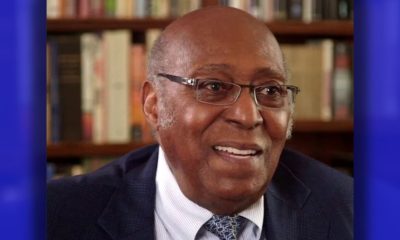City Government
OP-ED: Ferguson Is a Wake-Up Call for America and Oakland
In 2013, police killed 400 people in the United States. Most died with barely a blip on the world’s screen.
Michael Brown’s death was not unique. He was African American, young, male – and unarmed.
Ferguson Police Officer Darren Wilson shot him six times in broad daylight – apparently for running away when Officer Wilson tried to arrest him for jay walking.
The rage of a community sick and tired of poverty, unemployment, bad schools, bad housing and hopelessness exploded.
It happens all over. In Oakland, Alameda County sheriffs recently shot, and killed, apparently unarmed 23-year-old African-American Jacorey Calhoun. Calhoun was allegedly a suspect in a crime that had occurred almost a month earlier, but no one is explaining why he was killed.
Deputy Derek Thomas, who killed Mr. Calhoun, has a history of misconduct complaints.
The police play contradictory roles – people want them to safeguard our lives and property. Society employs them for social control.
Oakland’s police are not members of the community. The vast majority do not live in Oakland. And they do not solve the majority of violent crimes that afflict our neighborhoods.
Being a member of the Oakland community would mean a level of mutual accountability between officers and residents – with a zero tolerance for rogue officers who run roughshod over vulnerable community members.
Oakland is infamous for the police violence that led to 541 police abuse lawsuits from Jan. 1, 2000, to Aug. 21, 2012. According to the City Attorney, Oakland paid out $11,466,868 to resolve 20 of these cases.
This does not include the $10.9 million spent to settle the Riders case and millions more spent to monitor and continue to argue about OPD’s compliance with it. Or the $7 million spent to resolve the Occupy Oakland cases.
Oakland’s police, like those in Ferguson, were transformed by the military hardware that began to arrive with the “war on drugs” in 1980 – tanks, helicopters and assault rifles.
Like Ferguson, this equipment is used to suppress protests – as it did against the Oscar Grant movement in 2009-2010 and the Occupy movement in 2011
What about the social contract, the unwritten agreement between individuals and the government under which people accept the government’s authority over aspects of their lives in exchange for the security and other benefits the government is supposed to provide?
When tens of millions of people are excluded from the benefits provided to the privileged and the wealthy – social decay and disorder are inevitable.
In the U.S., the richest one percent control more wealth than the bottom 90 percent. In Oakland, the top 20 percent of households receives 49 percent of the total income; the bottom 20 percent receives three percent. Unemployment in Alameda County is 11 percent; for African Americans the number is doubled.
Three-quarters of our Oakland students qualify for free-or-reduced lunches; 42 percent are Hispanic, 29 percent are African American. Only 50 percent of African-American and Latino students graduate from Oakland high schools within four years of starting.
The state average is 80 percent.
This situation is a recipe for disaster. The health of American society will depend upon its ability to close the income and privilege gaps that divide the rich and the poor, particularly people of color clutched in the devastating grip of poverty.
We can make the changes we need. We can re-focus the police department on serving our communities and protecting us from violent crime. We can return the military hardware to the federal government and adopt a zero tolerance policy for police misconduct.
We can improve our schools and insist on the right of every child to learn. We can raise the minimum wage to $15 and create good jobs for working people in our new hotels and restaurants, installing solar power, and providing other 21st Century services.
We can protect tenants’ rights against evictions and build affordable housing for working people with contributions from the developers who want to create high-end housing.
Changing the world is tough. But so are Oaklanders. Together, we can create an Oakland grounded in principles of social and economic justice. And we can start on Nov. 4.
Dan Siegel is a civil rights attorney in Oakland and a candidate for mayor.
Activism
Oakland Post: Week of April 17 – 23, 2024
The printed Weekly Edition of the Oakland Post: Week of April 17 – 23, 2024

To enlarge your view of this issue, use the slider, magnifying glass icon or full page icon in the lower right corner of the browser window. ![]()
Bay Area
Oakland Finishes Final Draft of Downtown Specific Plan for Potential City Improvements
In late March, Oakland’s city administration announced the final draft of their Downtown Specific Plan, a blueprint for city improvements and developments over the next 20 years. The comprehensive 474-page plan lays out policies for downtown developments that will increase economic, social and cultural, and communal opportunities for residents and workers who frequent this essential hub in Oakland.

By Magaly Muñoz
In late March, Oakland’s city administration announced the final draft of their Downtown Specific Plan, a blueprint for city improvements and developments over the next 20 years.
The comprehensive 474-page plan lays out policies for downtown developments that will increase economic, social and cultural, and communal opportunities for residents and workers who frequent this essential hub in Oakland.
Several departments over the course of eight years developed the plan, with two phases that emphasized a need for community input from local stakeholders, such as leaders and residents, and a focus on the role of social and racial equity in past and future developments.
Throughout the extensive plan, the concept of equity for marginalized communities is embedded with each goal and priority for the improvements to downtown. It acknowledges that social and racial barriers are preventing these communities from thriving on an equal playing field.
The authors identified six key disparities, or ‘equity indicators’, that set the baseline for how success will be measured for the improvements. These indicators include the burden of housing costs, homelessness, displacement, disconnected youth, unemployment rate and median income.
The plan is also broken up into chapters, each describing a major issue or topic that is plaguing downtown residents and workers, such as mobility, culture preservation, community health and sustainability, and land use and urban design.
Within each chapter, the authors dedicate a section to the impacts of the COVID-19 pandemic for the various areas of interest, illustrating how disparities and inequities increased before and after the disease’s peak.
Two major issues highlighted in the plan are economic opportunity and housing and homelessness. Both of these issues have been aggravated by the pandemic and require substantial support and resources to move forward.
Many reports coming out of the commercial and residential districts downtown have blamed the rise in crime and cost of living as reasons for leaving Oakland for other cities or closing down indefinitely.
The plan attributes rising rents of both residential and commercial properties to the displacement of local businesses and entrepreneurs. Downtown also has an imbalance in the jobs to housing ratio, which limits access to jobs as commuting distances increase.
Other concerns for the local economy are barriers to employment opportunities for workers of color, non-English speakers, and those with limited access to transportation. As stated in the plan, downtown also has a lack of vacancies near public transit hubs, such as BART, bus stops or ferry terminals, which could save workers money and time for their commutes into the city.
According to the downtown plan, the average unemployment rate for the white population was 5.9%, but the Asian population was at 6.7%, and for the Black population it was even higher at 10.4%.
The proposed solutions for the lack of economic prosperity include providing assistance to local businesses owned by people of color, reinforcing downtown as the ‘place to be’ for nightlife entertainment, and building businesses closer to public transit.
The addition of over 18.3 million (m) sq. ft. of new commercial space, 1.3m sq. ft. of new institutional space, and 500,000 sq. ft. of new industrial space, could potentially create almost 57,000 jobs downtown.
Housing and homelessness, issues closely tied to economic prosperity, are top concerns for Oakland residents. High rents have led to displacement and homelessness for those unable to keep up with the rising costs of the Bay Area.
Over 5,000 people are currently experiencing homelessness in Oakland, according to 2022 Point In Time data. 60% of this population is Black despite only making up nearly 20% of the total city population.
The plan explains that by adding nearly 29,000 new homes and expanding affordable housing units across the city by 2040, this would help alleviate the stress of obtaining and affording a home.
Strategies proposed to tackle the housing and homelessness crisis include increasing renter protections, providing additional shelters and services for homeless residents, and promoting homeownership in downtown with first-time buyer assistance and proactive assistance to vulnerable homeowners.
The plan acknowledges that the implementation of changes and developments amongst the several concerns outlined in the document will take time, both in short and long term periods.
To better explain how and when each project will be addressed over the course of the next two decades, a detailed 123-page graph shows which agencies, potential funding sources, and costs come with the goals.
The Oakland Planning Commission and Landmarks Preservation Advisory Board will each hold public hearings regarding the final draft of the Downtown Plan in May and June.
City Government
LAO Releases Report on Racial and Ethnic Disparities in California Child Welfare System
Racial inequalities in California’s child welfare system disproportionately impact poor Black and Native American children, according to a report released April 3 by the nonpartisan Legislative Analyst’s Office (LAO). The report, which was presented to the Assembly Subcommittee No. 2 on Human Services — chaired by Assemblymember Corey Jackson (D-Moreno Valley) — states that the proportion of low-income Black and Native American children in foster care is four times larger than other racial and ethnic groups in the state.

Racial inequalities in California’s child welfare system disproportionately impact poor Black and Native American children, according to a report released April 3 by the nonpartisan Legislative Analyst’s Office (LAO).
The report, which was presented to the Assembly Subcommittee No. 2 on Human Services — chaired by Assemblymember Corey Jackson (D-Moreno Valley) — states that the proportion of low-income Black and Native American children in foster care is four times larger than other racial and ethnic groups in the state. Half of the children from each racial group has experienced some level of child welfare involvement before reaching legal age.
Jackson is a member of the California Legislative Black Caucus.
“Racial and ethnic disproportionality and disparities are present within initial allegations and persist at all levels of the system — becoming the most pronounced for youth in care,” the report states.
The disparities have persisted over the last decade across the state, the LAO found, adding that Black children living in poverty are more likely to enter foster care. State data shows that there is a correlation between poverty and foster placement in each county.
“Throughout all levels of the child welfare system, families experiencing poverty are more likely to come to the attention of and be impacted by the child welfare system,” stated the report.
Overall, the report revealed that more than half of the families affected by the state child welfare system earn $1,000 per month, significantly less than the national average of $5,000 a month.
The financial disparities highlighted in the LAO report align with existing research indicating that poverty is among the main factors contributing to the likelihood of child maltreatment. State anti-poverty programs include cash aid, childcare subsidies, supportive housing, and nutrition assistance.
-

 Activism4 weeks ago
Activism4 weeks agoOakland Post: Week of March 20 – 26, 2024
-

 #NNPA BlackPress3 weeks ago
#NNPA BlackPress3 weeks agoCOMMENTARY: D.C. Crime Bill Fails to Address Root Causes of Violence and Incarceration
-

 #NNPA BlackPress3 weeks ago
#NNPA BlackPress3 weeks agoMayor, City Council President React to May 31 Closing of Birmingham-Southern College
-

 #NNPA BlackPress3 weeks ago
#NNPA BlackPress3 weeks agoCOMMENTARY: Lady Day and The Lights!
-

 #NNPA BlackPress3 weeks ago
#NNPA BlackPress3 weeks agoFrom Raids to Revelations: The Dark Turn in Sean ‘Diddy’ Combs’ Saga
-

 #NNPA BlackPress3 weeks ago
#NNPA BlackPress3 weeks agoBaltimore Key Bridge Catastrophe: A City’s Heartbreak and a Nation’s Alarm
-

 #NNPA BlackPress3 weeks ago
#NNPA BlackPress3 weeks agoBaltimore’s Key Bridge Struck by Ship, Collapses into Water
-

 Activism3 weeks ago
Activism3 weeks agoOakland Post: Week of March 27 – April 2, 2024




















































